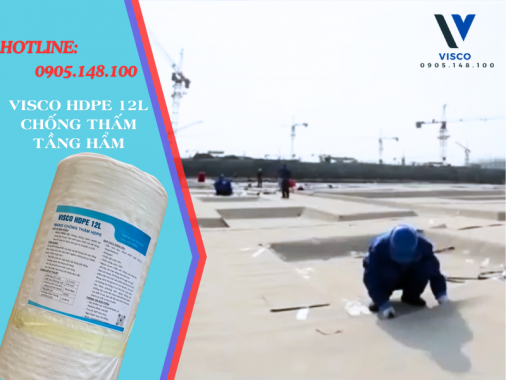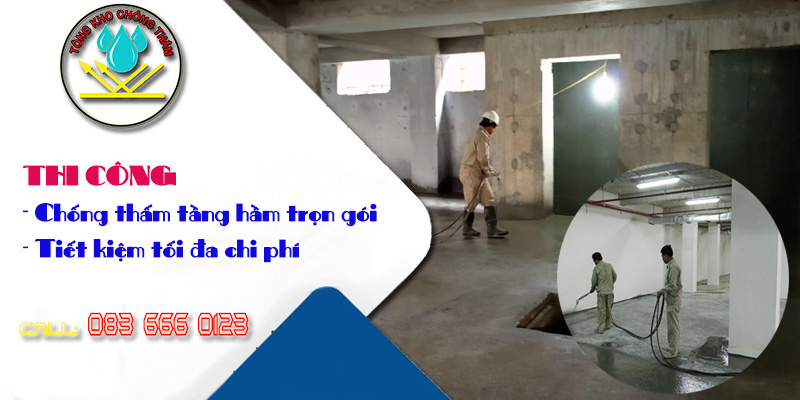
ADVANTAGES
Structural protection: Prevents water seepage, prolongs structural life.
Protect assets: Prevent moisture, damage to stored assets.
Increase property value: Reliable, create better value for property.
Long-term cost reduction: Prevent damage, avoid repair costs later.
Basement waterproofing plays an important role in preventing the ingress of water from all directions. This is an extremely effective waterproofing solution that works from bottom to top to ensure water resistance for the entire basement space.

The basement waterproofing includes a number of important items, especially the basement floor and basement wall waterproofing. By applying insulation and waterproofing measures, we ensure that there is no ingress of water from the outside environment into the basement space.
|
Professional basement waterproofing construction | 24/7 consultation Currently, there are quite a few methods applied to waterproofing basements, including: 1. Use Sika . waterproofing products Quality products from Sika have been proven effective in preventing water penetration, while creating a strong protective layer for the basement. 2. Apply hot torch film The torch waterproof membrane is designed for effective waterproofing and provides reliable insulation for basements. 3. Paint and solution to sweep basement walls Special waterproofing paints and coatings help protect basement walls from water infiltration, and at the same time increase the durability of the building. 4. Use self-adhesive film Self-adhesive membrane is an advanced method that creates a seamless and effective waterproofing membrane for basement floors and basement walls. 5. Use waterproof chemicals Specialized chemicals can be applied to create a strong and durable waterproofing layer that prevents water penetration from all angles. 6. Apply reverse waterproofing method The reverse waterproofing method is often used to form a waterproof layer from the outside of the basement wall, creating a barrier to prevent water from entering the basement. |
In the field of construction engineering, basement waterproofing work is considered an integral part. In particular, the basement is the place to place the fixed foundation for the entire building. The strength of that foundation is strongly dependent on waterproofing, as water can have a negative effect on the adhesion of building materials.
With these factors in mind, the application of an effective and high-performance basement waterproofing solution is the key goal. This construction process requires professionalism and extensive knowledge of waterproofing technologies, materials and methods. Ensure that all items related to basement waterproofing are done carefully and scientifically to ensure the sustainability and efficiency of the construction.
What are the advantages of basement waterproofing?
Basement waterproofing has many important advantages, helping to protect the infrastructure and create a safe and dry environment for the building. Here are some of the main advantages of basement waterproofing:
1. Asset and Infrastructure Protection
Basement waterproofing prevents water and grease from the outside environment from entering the structure, helping to prevent water damage and corrosive substances. This protects the property and increases the life of the building.
2. Ensure a clean and safe environment
Basement waterproofing helps to prevent the penetration of water from the underground into the basement, preventing the creation of a favorable environment for bacteria, mold and creating conditions for a clean and safe environment.
3. Minimize degradation
Water and corrosive agents are the main causes of building deterioration. Basement waterproofing prevents their ingress, which increases life span and reduces maintenance and repairs.
4. Facilitating a variety of uses
Waterproof basements can be used for goods storage, laundry room reservations, parking lots, engineering rooms and many other applications. The ability to create diverse use spaces helps to optimize space and increase the use value of the building.
5. Long-term cost savings
Grease and water seepage can cause significant damage to infrastructure and require huge costs to remediate. By waterproofing the basement from scratch, you can save on maintenance and repair costs in the future.
6. Prevention of health problems
Soaking water and moisture in the basement can create conditions for bacteria and mold to grow, posing a health risk to those living or working in the area. Basement waterproofing helps prevent health related problems.
Why should basement waterproofing construction?
Basement is an important part of construction projects, and ensuring the safety and sustainability of basements is a top goal. During the construction and maintenance of the work, the basement waterproofing cannot be ignored. Here are the reasons why basement waterproofing is an important factor.
Protect the overall structure of the building
The basement plays an important role in bearing the weight of the building, providing stability for all other floors. If the basement is flooded, water can enter the structure and cause durability and stability problems. Basement waterproofing helps prevent water ingress, protecting the overall structure of the building from weakening and damage.
Prevent flooding and limit damage
A flooded basement can lead to flooding when heavy rains or storms come. Water can penetrate through cracks and holes in the structure, causing flooding and serious damage to both the structure and the property inside. Basement waterproofing helps prevent flooding and minimizes damage from water seepage.
Save on maintenance and repair costs
Water seepage can cause wear and tear on building materials such as concrete, steel and wood. This not only weakens the structure but also increases maintenance and repair costs later on. By waterproofing the basement, you can reduce the risk of material damage and save money on maintenance and repair costs.
Protecting health and living environment
A damp and waterlogged basement can create favorable conditions for the growth of mold and bacteria. This not only affects the health of the people living in the building, but can also cause environmental problems. Basement waterproofing helps maintain a healthy living environment and creates safe conditions for residents.
In short, basement waterproofing is an important part of the construction and maintenance process. It helps to protect the overall structure, prevent flooding, save on maintenance and repair costs, as well as maintain a healthy living environment for residents.
Basic basement waterproofing construction process
The basement waterproofing process is an important part of construction to ensure the sustainability and safety of the building. Below are the steps commonly used in basement waterproofing construction:
1. Pretreatment and surface preparation
- Surface Cleaning: Remove dust, grease, dirt and other materials remaining on the surface by rinsing or using other methods.
- For concrete surfaces: Check and repair holes and cracks using waterproofing or concrete repair materials.
2. Create a base waterproof layer
Apply a base waterproofing layer on the concrete surface to create a waterproof barrier. Commonly used waterproofing materials include waterproofing paints, waterproofing adhesives, waterproofing membranes, and preliminary waterproofing systems.
3. Waterproof membrane coating
Apply surface waterproofing membrane. Waterproofing membranes can be bituminous membranes, HDPE (high temperature resistant polyethylene) membranes, PVC (polyvinyl chloride) membranes and other types of waterproofing membranes.
For basements with a lot of strong water effects, an additional coating can be used to protect the waterproofing membrane from mechanical and chemical factors.
4. Crack waterproofing
Treat large cracks using elastomeric waterproofing adhesives for sealing and flexibility. This is important as any cracks can be weak points for water penetration.
5. Test and check
Perform a test test to ensure the integrity of the waterproofing, including a pressure test, an oil test, or a water test. Performing a waterproofing process test ensures that there are no weak points in the waterproofing system.
6. Apply the finishing layer
After the waterproofing layer has been applied and tested, finish the basement by placing other building materials such as mortar, bricks, paint, etc.
7. Routine maintenance and inspection
Regular inspection and maintenance to ensure the waterproofing of the basement over time.
Note that specific procedures may vary based on building type, materials used, and specific environmental conditions. It is also important to learn regional or national regulations and guidelines to ensure that waterproofing is done properly.